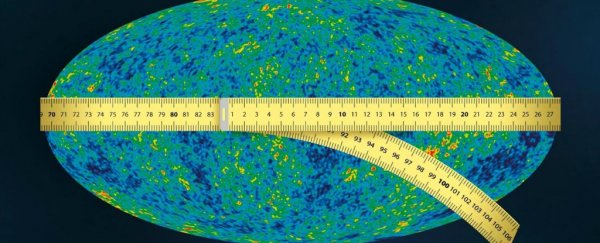Researchers from Russia have, for the first time, been able to measure the amount of dark matter the Universe has lost since the Big Bang some 13.7 billion years ago, and calculate that as much as 5 percent of dark matter could have deteriorated.
The finding could explain one of the biggest mysteries in physics - why our Universe appears to function in a slightly different way than it did in the years just after the Big Bang, and it could also shed insight into how it might continue to evolve in future.
"The discrepancy between the cosmological parameters in the modern Universe and the Universe shortly after the Big Bang can be explained by the fact that the proportion of dark matter has decreased," said co-author Igor Tkachev, from the Institute for Nuclear Research in Moscow.
"We have now, for the first time, been able to calculate how much dark matter could have been lost, and what the corresponding size of the unstable component would be."
The mystery surrounding dark matter was first brought up way back in the 1930s, when astrophysicists and astronomers observed that galaxies moved in weird ways, appearing to be under the effect of way more gravity than could be explained by the visible matter and energy in the Universe.
This gravitational pull has to come from somewhere. So, researchers came up with a new type of 'dark matter' to describe the invisible mass responsible for the things they were witnessing.
As of right now, the current hypothesis states that the Universe is made up of 4.9 percent normal matter – the stuff we can see, such as galaxies and stars – 26.8 percent dark matter, and 68.3 percent dark energy, a hypothetical type of energy that's spread throughout the Universe, and which might be responsible for the Universe's expansion.
But even though the majority of matter predicted to be in the Universe is actually dark, very little is known about dark matter - in fact, scientists still haven't been able to prove that it actually exists.
One of the ways scientists study dark matter is by examining the cosmic microwave background (CMB), which some call the 'echo of the Big Bang'. The CMB is the thermal radiation left over from the Big Bang, making it somewhat of an astronomical time capsule that researchers can use to understand the early, newly born Universe.
The problem is that the cosmological parameters that govern how our Universe works – such as the speed of light and the way gravity works – appear to differ ever so slightly in the CMB compared to the parameters we know to exist in the modern Universe.
"This variance was significantly more than margins of error and systematic errors known to us," Tkachev explains. "Therefore, we are either dealing with some kind of unknown error, or the composition of the ancient universe is considerably different to the modern Universe."
One of the hypotheses that might explain why the early Universe was so different is the 'decaying dark matter' (DDM) hypothesis - the idea that dark matter has slowly been disappearing from the Universe.
And that's exactly what Tkachev and his colleagues set out to analyse on a mathematical level, looking for just how much dark matter might have decayed since the creation of the Universe.
The study's lead author, Dmitry Gorbunov, also from the Institute for Nuclear Research, explains:
"Let us imagine that dark matter consists of several components, as in ordinary matter (protons, electrons, neutrons, neutrinos, photons). And one component consists of unstable particles with a rather long lifespan.
In the era of the formation of hydrogen, hundreds of thousands of years after the Big Bang, they are still in the Universe, but by now (billions of years later), they have disappeared, having decayed into neutrinos or hypothetical relativistic particles. In that case, the amount of dark matter in the era of hydrogen formation and today will be different."
To come up with a figure, the team analysed data taken from the Planck Telescope observations on the CMB, and compared it to different dark matter models like DDM.
They found that the DDM model accurately depicts the observational data found in the modern Universe over other possible explanations for why our Universe looks so different today compared to straight after the Big Bang.
The team was able to take the study a step further by comparing the CMB data to the modern observational studies of the Universe and error-correcting for various cosmological effects – such as gravitational lensing, which can amplify regions of space thanks to the way gravity can bend light.
In the end, they suggest that the Universe has lost somewhere between 2 and 5 percent of its dark matter since the Big Bang, as a result of these hypothetical dark matter particles decaying over time.
"This means that in today's Universe, there is 5 percent less dark matter than in the recombination era," Tkachev concludes.
"We are not currently able to say how quickly this unstable part decayed; dark matter may still be disintegrating even now, although that would be a different and considerably more complex model."
These findings suggest that dark matter decays over time, making the Universe move in different ways than it had in the past, though the findings call for more outside research before anything is said for certain.
Even so, this research is another step closer to potentially understanding the nature of dark matter, and solving one of science's greatest mysteries - why the Universe looks the way it does, and how it will evolve in the future.
The team's work was published in Physical Review D.
